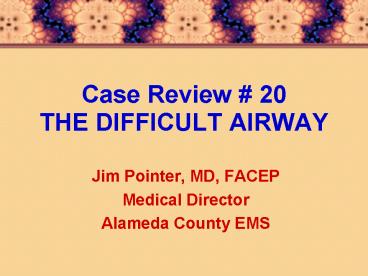Case Review - PowerPoint PPT Presentation
1 / 32
Title:
Case Review
Description:
Helpful devices for intubation. that are NOT practical in the field. Light wands. Fiberoptics ... Used in surgery. Risk of aspiration. Rescue technique. Tube ... – PowerPoint PPT presentation
Number of Views:88
Avg rating:3.0/5.0
Title: Case Review
1
Case Review 20THE DIFFICULT AIRWAY
- Jim Pointer, MD, FACEP
- Medical Director
- Alameda County EMS
2
INTRODUCTION
- Field intubation success rates
- Oral 80-95
- Nasal 60-85
- RSI not universally available
- Recognition of difficult airway is important
- At least one backup, rescue airway technique is
essential
3
DEFINITION
- Difficult airway ANYTHING that interferes with
ventilation or intubation - Anatomic
- Traumatic
- Infectious
- Allergic
- Behavioral
4
CLUES TO LOOK FOR
CL
- Prominent incisors
- Limited jaw / mouth opening
- Short neck
- Big tongue
- Small mandible
- Limited cervical mobility
- Facial trauma
- Burns
- Neck injury
- Obesity
- Foreign bodies
- Children
- Infections
- Allergic edema
- Neoplasm / irradiation
- Inhalation injuries
- Facial hair
5
FOUR Ds
- Distortion
- Disproportion
- Dysmobility
- Dentition
6
MNEUMONIC BONES
- Beard
- Obese
- No teeth
- Elderly
- Snoring (sleep apnea)
7
MALLAMPATI CLASSIFICATION
Class I Class II Class III Class IV
8
ANATOMY
9
60-SECOND EXAM LEMON
- Look for external difficulty
- Evaluate using 332 rule
- 3 fingers fit in mouth
- 3 fingers fit from mentum
- to hyoid cartilage
- 2 fingers fit from mandible
- to top of thyroid cartilage
- Mallampati rule (class I II)
- Obstruction
- Neck mobility
10
10-SECOND QUICK EXAM
- Can you see the uvula?
- Can you fit 3 fingers from mentum to hyoid?
- Can the patient extend head back on neck?
11
PREPARATION
- Prepare equipment ahead of time
- Check and recheck
- Gather all airway devices
- in one bag or area
- Pre-oxygenate with 100 O2
12
SNIFFING POSITION
- Flex neck on chest 35
- Extend head on neck 80
- Use pillow or other
- object under occiput
13
BURP, OELM, ELM
- External
- Laryngeal
- Manipulation
- Backward
- Upward
- Rightward
- Pressure on thyroid cartilage
- Optimal
- External
- Laryngeal
- Manipulation
Intubator uses BURP to establish position
assistant holds in place
14
Helpful device for intubation that is practical
- GUM ELASTIC BOUGIE (GEB)
- Used in England
- Cheap
- Good in patients in whom
- only epiglottis is visualized
15
Rotate ET tube until bevel faces posteriorly
GEB in trachea
16
Helpful devices for intubationthat are NOT
practical in the field
- Light wands
- Fiberoptics
- Tracheostomy lights
- Blind techniques
17
Adjuncts to Nasotracheal Intubation
- Endotrol
- Afrin and lidocaine on nasal trumpet
- BAAM whistle
- Positioning
- straight back, not upward
18
Endotrol
19
BAAM Whistle
20
RESCUE AIRWAYS
21
Laryngeal Mask Airway (LMA ) and Intubating LMA
(ILMA)
- Used in surgery
- Risk of aspiration
- Rescue technique
- Tube must be used
- with curve reversed
22
LMA and ILMA (cont.)
- Intubating LMA
- Accepts larger tube
- (8.0)
- Can be used for rescue
- Is expensive
- LMA ILMA not
- used in California EMS
23
COMBITUBE
- Most commonly used rescue airway in EMS
24
Needle or Surgical Cricothyrotomy
- Needle must be used with high powered O2 in
adults - Surgical techniques forbidden in California EMS
25
Preferred Surgical Cricothyrotomy
- Seldinger technique
- Catheter-over-needle
- Wire-through-needle
26
Confirmation of Intubation Techniques
- Auscultation
- Both lung fields and epigastrum
- Persistent oxygenation on pulse oximetry
- Chest wall motion
- Tube fogging
- Chest x-ray
- End-tidal CO2
- Esophageal detector device (EDD)
27
Confirmation of Intubation Techniques (cont.)
- ALL techniques may be unreliable!
- End-tidal CO2 and EDD are MOST reliable.
- Both are mandatory in Alameda County policy 10102
28
End-tidal CO2
- Colorimetric
- Capnography
- Capnometry
- Drawback
- Cardiac arrest state
29
(No Transcript)
30
Esophageal Detector Device
- Drawbacks
- Air in stomach causes false positives
- Poorer performance in obese patients
- Cold can impact bulb type
- MUST be used correctly
31
SUMMARY
- Be prepared mentally logistically
- Know how to assess a potential difficult airway
- Use proper techniques
- Utilize assistive devices to facilitate intubation
32
SUMMARY (cont.)
- Know when to use rescue techniques
- Confirm your intubation using multiple techniques
- End-tidal CO2 and EDD are mandatory!
- Monitor patient using pulse oximetry and
end-tidal CO2































